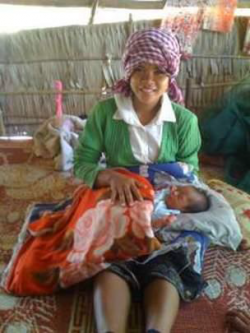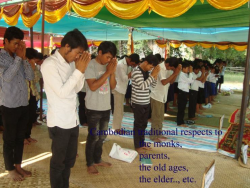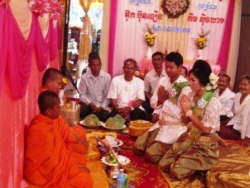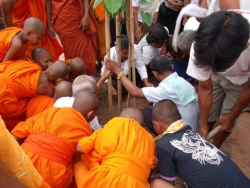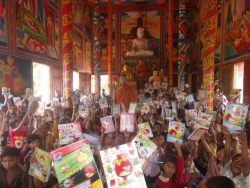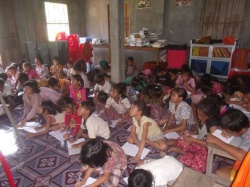The Impact of Buddhism on Cambodian Way of Life by Venerable Suy Sovann
Introduction
Buddhism was founded well over two thousand years ago, in the 5th or 6th century BCE, its ideas and practices are still evident in societies throughout the world today. Buddhism is the world's fourth largest religion, with about 350 million living adherents. Besides impacting those who study and practice Buddhism as their primary religion, Buddhism shapes modern philosophical outlooks, psychological conditions, and political landscapes.
In Cambodia, Buddhism is a religion of nation. 95 percent of its populations are followers of the Buddha, and the monks hold an important place in society. As known, for Cambodians, Buddhism is more than just a religion. In accordance with the history of Buddhism, King Ashoka sent missionaries to the land of Suwannaphum, which has sometimes been identified as the mainland southeast Asian region of Mon (now a stat in Myanmar, the stat of Mon) and Khmer (now Cambodia) people. The unconfirmed Singhalese sources state that Buddhism was introduced to Suvannaphum, or the 'Golden Peninsula', as mainland Southeast Asia was once referred to, in the 3rd century B.C. under the reign of King Ashoka, the great Buddhist ruler. According to these sources, two monks, Sona and Uttara, were sent to propagate the doctrine of the Master in this region following the great council of 274 B.C. held in Asoka's capital Pataliputta, India. While this mission may be legendary, it indicates that Buddhism has been present in Southeast Asia for a long time. Various Buddhist sects and schools, including Tantrism, vied or coexisted with a dominant Brahamanism and indigenous animistic faiths for centuries before the rise of the classical Southeast Asian empires beginning in the 9th century A.D. In part through Indian merchant traders, Indian cultural influence was pervasive in this early period. In Funan (1st to 5th century A.D.) the first organized Khmer polity, the Khmer people embraced not only the diverse Brahmanic and Buddhist religions but also the social customs and mores of India.
Cambodian ways of life have been connected to what the Buddha taught more than 2555 years ago. The Buddhist monks and monasteries have played important roles to Cambodian societies from generation to generation. Here we may know how the Buddhism influences to Cambodian way of life.
Buddhist Impact to Cambodian Culture
For many centuries, Buddhist ideas and ideals have guided and influenced the lives and thoughts of countless human beings in many parts of the world. As Buddhists, our own experiences and discoveries in life are not enough to give a true perspective on life. To bring ourselves closer to the ideal of a well- balanced man or woman, we need to acquire, at least in outline, what is called a cultural grounding in the Buddha-Dhamma. Culture reveals to ourselves and others what we are. It gives expression to our nature in our manner of living and of thinking, in art, religion, ethical aspirations, and knowledge. Broadly speaking, it represents our ends in contrast to means. In Cambodia, Buddhist way of life and Cambodian Culture are inseparable.
Birth and death rituals
Actually, the birth of a child is a happy event for the family. According to traditional beliefs, however, confinement and childbirth expose the family, and especially the mother and the child to harm from the spirit world. A woman who dies in childbirth—crosses the river (chhlong tonle) in Khmer is believed to become an evil spirit. In traditional Khmer society, a pregnant woman respects a number of food taboos and avoids certain situations. These traditions remain in practice in rural Cambodia, but they have become weakened in urban areas. Some places, Buddhist monks have been invited to chant Paritta or Mantra for new born baby. They believe that by the power of Paritta, baby will be protected and escaped from dangers.
Death is not viewed with the great outpouring of grief common to Western society; it is viewed as the end of one life and as the beginning of another life that one hopes will be better. Buddhist Khmer usually are cremated, and their ashes are deposited in a stupa in the temple compound. A corpse is washed, dressed, and placed in a coffin, which may be decorated with flowers and with a photograph of the deceased. White pennant-shaped flags, called "white crocodile flags," outside a house indicate that someone in that household has died. A funeral procession consisting of a leader, Buddhist monks, members of the family, and other mourners accompanies the coffin to the crematorium. The spouse and the children show mourning by shaving their heads and by wearing white clothing. Relics such as teeth or pieces of bone are prized by the survivors, and they are often worn on gold chains as amulets. If the child is always ill, his or her parents can go and change the name of child.
Furthermore, Buddhism teaches Cambodian people to understand what the reality of life is. The funeral ceremony is held in accordance with Cambodian culture and Buddhism. Buddhist monks are invited to pray and preach Dhamma in the funeral ceremony. People have been trained to accept the truth of everything such, old age, sickness, death, separation and volitional action (kamma).
Childhood and adolescence
A Cambodian child may be nursed until two to four years of age. Up to the age of three or four, the child is given considerable physical affection and freedom. Children around five years of age also may be expected to help look after younger siblings. Children's games emphasize socialization or skill rather than winning and losing. Most children begin school when they are seven or eight. By the time they reach this age, they are familiar with the society's norms of politeness, obedience, and respect toward their elders and toward Buddhist monks. The father at this time begins his permanent retreat into a relatively remote, authoritarian role. By age ten, a girl is expected to help her mother in basic household tasks; a boy knows how to care for the family's livestock and can do farm work under the supervision of older males. Adolescent children usually play with members of the same sex. During his teens, a boy may become a temple servant and go on to serve a time as a novice monk, which is a great honor for the parents. In pre-communist days, parents exerted complete authority over their children until the children were married, and the parents continued to maintain some control well into the marriage. Age difference is strictly recognized with polite vocabulary and special generational terms for "you".
Children and youth are taught to do good deeds, speak politely, and think rightly according to the Buddhist way of life. They know how pay homage to the Buddha, the Dhamma, the Sangha, parents, the old ages and the elder. Children and youths are also taught about the difference between what is right action and what is wrong action. Hence ten wholesome courses of action‘ are called the good things to do 4 in life, namely
- 1- Avoidance of taking life
- 2- Avoidance of taking what is not given
- 3- Avoidance of sexual misconduct
- 4- Avoidance of lying speech
- 5- Avoidance of slander
- 6- Avoidance of using rude speech
- 7- Avoidance of idle chatter
- 8- Avoidance of greed
- 9- Avoidance of malevolence
- 10- Avoidance of wrong view
In the same way, there are ten unwholesome courses of action‘:
- 1- Taking life or harming other living beings
- 2- Taking what is not given
- 3- Committing sexual misconduct
- 4- Lying speech
- 5- Slander
- 6- Using rude speech
- 7- Idle chatter
- 8- Greed
- 9- Malevolence
- 10- Wrong view
Courtship and marriage
In Cambodia, premarital sex is deplored. The choice of a spouse is a complex one for the young male, and it may involve not only his parents and his friends, as well as those of the young woman, but also a matchmaker and a predictor. In theory, a girl may veto the spouse her parents have chosen. Courtship patterns differ between rural and urban Khmer; romantic love is a notion that exists to a much greater extent in larger cities. A man usually marries between the ages of nineteen and thirty, a girl between the ages of eighteen and twenty-five. After a spouse has been selected, each family investigates the other to make sure its child is marrying into a good family. In rural areas, there is a form of bride-service; that is, the young man may take a vow to serve his prospective father-in-law for a period of time. The traditional wedding is a long and colorful affair. Formerly it lasted three days, but in the 1980s it more commonly lasted a day and a half. Buddhist monks have been invited to offer a short sermon and recite prayers of blessing. Parts of the ceremony involve ritual hair cutting, tying cotton threads soaked in holy water around the bride's and groom's wrists, and passing a candle around a circle of happily married and respected couples to bless the union. After the wedding, a banquet is held. Newlyweds traditionally move in with the wife's parents and may live with them up to a year, until they can build a new house nearby. Again, after their wedding, parents always share the birthright with them. This is to show that Buddhist way of life is included. In Buddhism, all parents must practise their five duties towards their children. They are:
- 1- Refrain children from evils
- 2- Find ways for children to engage themselves in good deed
- 3- Give them a good education
- 4- Marry them into a suitable family
- 5- Share the birthright with them
Social organization
Khmer culture is very hierarchical. The greater a person's age, the greater the level of respect that must be granted to them. Cambodians are addressed with a hierarchical title corresponding to their seniority before the name. When a married couple becomes too old to support themselves, they may invite the youngest child's family to move in and to take over running the household. At this stage in their lives, they enjoy a position of high status. The individual Khmer is surrounded by a small inner circle of family and friends who constitute his or her closest associates, those he would approach first for help. People are trained to live harmoniously nowith harmony no m The nuclear family, consisting of a husband and a wife and their unmarried children, is the most important kin group. Within this unit are the strongest emotional ties, the assurance of aid in the event of trouble, economic cooperation in labor, sharing of produce and income, and contribution as a unit to ceremonial obligations. In rural communities, neighbors—who are often also kin—may be important, too. Fictive child-parent, sibling, and close friend relationships Cambodia transcend kinship boundaries and serve to strengthen interpersonal and interfamily ties. Beyond this close circle are more distant relatives and casual friends. In rural Cambodia, the strongest ties a Khmer may develop—besides those to the nuclear family and to close friends—are those to other members of the local community. A strong feeling of pride—for the village, for the district, and province—usually characterizes Cambodian community life.
Legally, the husband is the head of the Khmer family, but the wife has considerable authority, especially in family economics. The husband is responsible for providing shelter and food for his family; the wife is generally in charge of the family budget, and she serves as the major ethical and religious model for the children, especially the daughters. Both husbands and wives are responsible for domestic economic tasks. Cambodian Buddhists find that husbands or wives should know their own duties towards each other. Here Buddhism teaches "In five ways should a wife as the western direction be respected by a husband: by honoring, not disrespecting, being faithful, sharing authority, and by giving gifts. And, the wife so respected reciprocates with compassion in five ways: by being well-organized, being kindly disposed to the in-laws and household workers, being faithful, looking after the household goods, and being skillful and diligent in all duties.
The Role of Monks to Cambodian Communities
Cambodian Buddhism was instrumental in fomenting Khmer national identity and the independence movement in the 20th century, leading to Cambodian independence as a sovereign state. In their attempt to separate the Khmer people from their cultural allegiance to the neighboring Theravada kingdom of Siam, the French "protectors" nurtured a sense of Khmer identity by emphasizing Khmer- language studies and Khmer Buddhist studies. They established Pali schools within Cambodia to keep the Cambodian monks from traveling to Siam for higher education. These Khmer-language study centers became the birthplace of Cambodian nationalism.
In Cambodia, Buddhist monks traditionally were called upon to perform a number of functions in Cambodian life. They participated in all formal village festivals, ceremonies, marriages, and funerals. They also might have participated in ceremonies to name infants and in other minor ceremonies or rites of passage. Monks did not lead the ceremonies, however, because that role was given to the master of ceremonies; the monk's major function was to say prayers of blessing. They were often healers and, in traditional Khmer culture, they were the practitioners whose role was closest to that of modern psychiatrists. The monk traditionally occupied a unique position in the transmission of Khmer culture and values. By his way of life, he provided a living model of the most meritorious behavior a Buddhist could follow. He also provided the laity with many opportunities for gaining merit. For centuries monks were the only literate people residing in rural communities; they acted as teachers to temple servants, to novices, and to newly ordained monks. Until the 1970s, most literate Cambodian males gained literacy solely through the instruction of the sangha. In addition, during the era of French rule, convulsions of violence, led by Buddhist holy men, would periodically break out against the French. Significant advances were made in the education of Cambodian monks, both in specifically Buddhist topics and more general studies. Primary education of Cambodian children continued to take place at temple schools. Monks were also encouraged to become involved in community development projects. In the modern Cambodian society, Buddhist monks are more important to strengthen and promote the social morality. The members of the Orders are like nurses who help us take the medicine of Dhamma. The nurses remind us when we forget which pills to take. If we have difficulty swallowing huge pills, the nurses break them into smaller pieces for us. Similarly, the Sangha helps us practise the Dhamma correctly when we are confused. Any fellow practitioner who is more advance than us can be our spiritual friend who can help us.
The Role of Cambodian Monasteries to Society
The monasteries are not only places where the Buddhist monks live and practise the teachings of the Buddha, but they are also places where people come and learn the Buddhist doctrines for daily practices. Buddhism is still strong among the various Cambodian refugee groups throughout the world, although some younger monks, faced with the distractions of a foreign culture, have chosen to leave the clergy and have become laicized. One fascinating aspect of Buddhism in Cambodia is the role pagodas (Wats) play in development and poverty alleviation. Pagodas provide something like a safe-house for youth, where they have ready access to food, shelter, education and companionship. There aren‘t a whole lot of hurdles to clear before entering the pagoda – which essentially serves as a school‘ of sorts for monks, and individuals may fail their monk schooling, leave the pagoda, and return many times over. Presumably their lifestyles are not so monk-like out of pagoda-school hours.
Monasteries perform most of the major Cambodian annual festivals which are connected with Buddhist observances. The Khmer New Year Festival takes place in mid-April; it was one of the few festivals allowed under the Khmer Rouge regime. The Phcum Ben, celebrated in September or in October, is a memorial day for deceased ancestors and for close friends. Magha Puja, in January or February, commemorates the last sermon of the Buddha. Visakh Puja, in April or in May, is the triple anniversary of the birth, death, and enlightenment of the Buddha. The Rainy Retreat takes place in June or in July; it marks the beginning of a penitential season during which the monks must remain within the temple compounds. The Kathina marks the end of this season; celebrated in September, it features offerings, especially of robes, to the monks.
In Cambodia, the monasteries play so important roles to the society both in the past and in the present. Monasteries are like the hospitals where people come and get cured the physical and mental diseases. Monasteries are also schools where people come and learn several skills of living. Monasteries are the courts of Cambodian people too. People get resolved the problems while they get in the monasteries.
Conclusion
Cambodian ways of life are depending on Buddhism even not many people understand well Buddhism. Buddhism has its historical roots in India, and yet people all over the world consider themselves Buddhists today. Practitioners of Buddhism visit centers or temples where they can meditate and study together.
People are drawn, for example, to notions like karma ("deeds"), dharma ("natural law"), and reincarnation, yet some still consider themselves to be Christians, Jews, or even atheists. The stresses of modern life have led many people to embrace the Buddhist practice of meditation, as well as yoga, which developed alongside Buddhism as a related spiritual tradition in India. Meditation and yoga have positive psychological effects on people who perform them regularly, producing senses of peacefulness, centeredness, and spiritual awakening. Recognizing these effects, Cambodian psychologists have used Buddhist meditation techniques as a basis in developing common cognitive and behavior therapies. Again, people love to say that non-violence is a primary tenet of Buddhism, and some practitioners used this as reason for remaining relatively unengaged in political life. Nevertheless, there are Buddhists, including monks, throughout the world who consider it their religious duty to speak out against political regimes that oppress the majority of the people, and in doing so have impacted contemporary society.
Therefore, the impact of Buddhism on Cambodian way of life is seen every aspect of Cambodian life. People of Cambodia understand the core of Buddhism, ―All things arise from causes and conditions, all things also vanish because of causes and conditions. One is one‘s own refuge, who else could be refuge. I And ―As the seed, so the fruit. Who does good, receives good, who does evil receives evil.
=
Source
=
- "Culture, the Forgotten Dimension." in Development, Seeds of Change (Rome), N.3/4, 1981. Special issue of the journal of the Society for International Development.
- Anguttara Nikaya: An anthology of discourses from the Anguttara Nikaya, tr, Nyanaponika Thera and Bhikkhu Bodhi, BPS, Sri Lanka, 2007.
- Asian Rethinking on Development. A Symposium Jointly Organized by UNESCO and UN Asian Development Institute, New Delhi: Abhinav Publications, 1977.
- Bechert, Heinz. Buddhismus, Staat und Gesellschaft in den Laendern des Theravada Buddhismus. v.2. Wiesbaden: Otto Harrassowitz, 1967.
- Benda, Harry J. "The Structure of Southeast Asian History: Some Preliminary Observations." in Man, State, and Society in Contemporary Southeast Asia, ed. Robert O. Tilman. New York: Praeger Publishers, 1969.
- Black, C., The Educational Reconstruction of Education, Victor Gollancz Ltd, 1946.
- Bullough Jr, Robert, Kownles, J. Gary and Crow, Nedra, Emerging as a Teacher, Routledge, London, 1991.
- Digha Nikaya: The Long Discourses of the Buddha, tr, Maurice Walshe, Wisdom Publication, Canada, 1995.
- Ebihara, May. "Interrelations between Buddhism and Social systems in Cambodian Peasant Culture," in Manning Nash, et.al., Anthropological Studies in Theravada Buddhism. New Haven: Yale University Southeast Asia Studies, 1966.
- Gunatilleke, Godfrey, et.al. Ethical Dilemmas of Development in Asia. Lexington, Mass./USA: Lexington Books, 1983.
- Harvey, Peter, An Introduction to Buddhist Ethics, Cambridge University Press, 6th Edt, 2007.
- Hindery, Roderick, Comparative Ethics in Hindu and Buddhist Traditions, Motilal Banarsidass Publishers Private Limited, Delhi, 2nd Edt, 1996.
- Hitt, William D., Education as a Human Enterprise, Charles A. Jones Publishing Company, Worthington, Ohio,1973.
- Hommadi, A H, Higher Education in Third World, Indian Bibliographies Bureau, Delhi, 1931.
- http://en.wikipedia.org/wiki/Buddhism_in_Cambodia
- http://www.keap-net.org/buddhism_cambodia.htm
- http://www.mongabay.com/history/cambodia/cambodia-role_of_buddhism_in_cambodian_life.html
- Keown, Damien, Contemporary Buddhist Ethics, Routledge Curzon, London, 2000.
- Khmer Buddhist Research Center. Buddhism and the Future of Cambodia. Rythisen (Site 2 camp), Thailand: Khmer Buddhist Association, 1986.
- Lester, Robert C. Theravada Buddhism in Southeast Asia. Ann Arbor: University of Michigan Press,1973.
- Ling, Trevor, ed. Buddhist Trends in Southeast Asia. Singapore: Institute of Southeast Asian Studiesw, 1995.
- Löschmann, Heike. "Buddhismus und gesellschaftliche Entwicklung in Kambodscha seit der Niederschlagung des Pol-Pot-Regimes im Jahre 1979." Asien, No. 41 (Juli 1991).
- Majjhima Nikaya: the Middle Length Discourses of the Buddha, tr, Bhikkhu Nanamoli and Bhikkhu Bodhi, Wisdom Publication, 4th Edt, Canada, 2009.
- Peter, R.S., Authority, Responsibility and Education, George Allen and Unwin (Publishers) Ltd, 1973.
- Phra Debvedi (Prayudh Payutto). Buddhist Economics. tr. Dhammavijaya. Bangkok: Buddhadamma Foundation Publications, 1992.
- Pyinnyathiha, the Way to Social Harmony, Triple Gem Publication, Malaysia, 2002.
- Sovann Suy, Edited, Dhammapada (Khmer and English), Meng Hao Printing House, Cambodia, 2010.
- Steinberg, David Joel, ed., et.al. In Search of Southeast Asia. A Modern History. Honolulu: University of Hawaii Press, (1971) 1987.
- Tiwary, Mahesh, Perspective on Buddhist Ethics, Department of Buddhist Studies, Delhi, 1989.
- Verhelst, Thierry G. No Life Without Roots: Culture and Development. tr. B. Cumming. London: Zed Books, (1987) 1990.
- Visuddhimagga: the Path of Purification, tr, Bhikkhu Nanamoli, BPS, Sri Lanka, 4th Edt, 2010.
- Walatara, Douglas, Education and Attention: A Basis for the Humanities, Lake House Investments Limited, Sri Lanka, 1980.
- Walford, Geoffrey, Privatization and Privilege in Education, Routlege, London, 1990.
- Wolters, O.W. History, Culture, and Region in Southeast Asian Perspectives. Singapore: Institute of Southeast Asian Studies, (1982) 1989.
Source
Author: Venerable Suy Sovann
buddhismandaustralia.com
